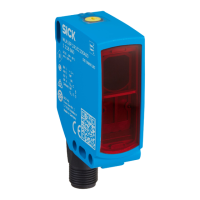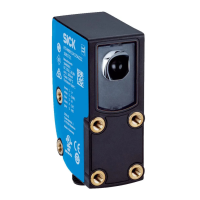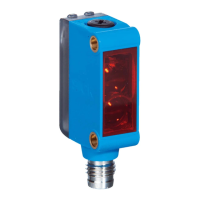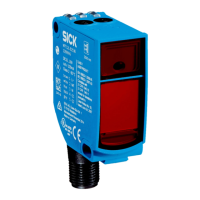OPERATING INSTRUCTIONS| Bulkscan LMS5118014829/ZNC5/2017-06-06| SICK
Subject to change without notice
81
APPENDIX
13 Appendix
13.1 Telegram reference
To work with telegrams, please read the following sections:
• CongurationoftheBulkscanusingtelegrams(see"7.2CongurationoftheBulk-
scan using telegrams“ on page 51).
• Notation and examples (see below).
The available telegrams are divided as follows based on the structure of the software
user interface:
• Logging in to the sensor/Logging out of the sensor (see "13.1.2 Logging in to the
sensor/Logging out of the sensor“ on page 82).
• Savingthecongurationinthenon-volatilememory(see"13.1.3Savingthecongu-
ration in the non-volatile memory“ on page 83).
• Device information (see "13.1.4 Device information“ on page 83).
• Operating mode/Teach-in (see "13.1.5 Operating mode/Teach-in“ on page 83).
• Measured value (see "13.1.6 Measured values“ on page 84).
• Measurement (see "13.1.7 Measurement“ on page 84).
• System (see "13.1.8 System“ on page 85).
• Digital inputs (see "13.1.10 Digital inputs“ on page 86).
• Digital outputs (see "13.1.11 Digital outputs“ on page 87).
• Reference measurement (compensation function) (see "13.1.12 Reference measure-
ment (compensation function)“ on page 88).
• Service data (see "13.1.13 Service data“ on page 90).
• Error codes (sFA) (see "13.1.14 Error codes (sFA)“ on page 90).
13.1.1 Notation and examples
Notation
The individual telegram sections must each be separated by a space (ASCII code 32,
20 h). The Bulkscan interprets the parameters transferred as follows:
• Parameters with a leading "+" or "–" are interpreted as a decimal value (ASCII nota-
tion).
• Parameters without a leading "+" or "–" are interpreted as a hexadecimal value (ASCII
notation).
• TheBulkscaninterpretseachparameterindividually,i.e.,thedifferentnotationscan
be mixed within a telegram.
• All examples used in the following telegram lists refer to the CoLaA protocol.
Structure of the data
The data comprises a command, a variable name or a method name, as well as any
necessary parameters.
Request <STX> sMN
SetAccessMode
03 F4724744 <ETX>
Reply <STX> sAN
SetAccessMode
1 <ETX>
Frame
Method: Login to the sensor
Parameter: Authorized user
Parameter: Password
Frame
Command: Execute method
Commands
The Bulkscan replies to each telegram with the reply command to match the request
command.
Request commands Meaning Reply commands
sRN Output variable once sRA
sEN ... 1 Output variable continuously sEA … 1, sSN
sEN ... 0 Stop continuous variable output sEA … 0
sWN Write variable sWA
sMN Execute method (executed without errors) sAN
sAN … 1
Execute method (error, not executed) sAN … 0
(Other) Command or data unknown sFA
Tab. 20: Request command and the corresponding reply commands
Variable types
The variable types are given in the telegram syntax. Following variable types are possi-
ble:
Variable types Length (Byte) Value range
bool_1 1 0 oder 1
uint_8 1 0 … 255
int_8 1 –128 … +127
uint_16 2 0 … 65.535
int_16 2 –32.768 … +32.767
uint_32 4 0 … 4.294.967.295
int_32 4 –2.147.483.648 … +2.147.483.647
oat_32 4 1,5 × 10
–45
… 3,5 × 10
38
string Fixed Example: String of length 6: "123ABC"
Important: Strings are not null-terminated
Tab. 21: Variable types
• The information in the "Length" column of the table refers to the binary transfer of
the numeric parameters.
• The information in the "Value range" column in the table refers to the value range
mathematically possible for the variable type. The actual value ranges for the pa-
rameters may be different.
• Examples: Thevariabletype"oat_32"referstotheIEEE754single-precisionoat-
ing-point standard.
Telegram example Result
Outputvariable(volumeowrate):
Request: <STX>sRN mvVolumeFlow<ETX>
Reply: <STX>sRA mvVolumeFlow 43AF6E14<ETX>
Thevolumeowrateis
350.86 m³/h (43AF6E14h).
Note
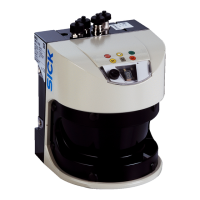
